Compact and cost-effective: LZH researches on novel USP laser systems
Surface-emitting semiconductor lasers are particularly suitable for developing lasers with customized wavelengths. Until now, optically pumped systems have been used to achieve high power levels. However, these are very complex to assemble. Electrically pumped systems, on the other hand, can only be realized with small emitting areas and therefore low power in the fundamental mode. This limits their application, for example in the field of material processing.
Goal: Compact semiconductor USP laser with high power
The researchers in the ED-VECSEL project aim to realize electrically pumped systems emitting in the fundamental mode with ultra-short pulses of high power and simple assembly. To achieve this, they will investigate the feasibility of a system consisting of an electrically pumped semiconductor structure with a large emission surface and a matching resonator with, if possible, only a single additional optical component (resonator output coupler). As part of the project, the LZH is responsible for the investigation and integration of an optimized electrically pumped semiconductor chip into an USP laser system.
The project "Electrically pumped semiconductor disk laser for ultrashort pulse generation (ED-VECSEL)" is funded by the Federal Ministry of Education and Research (grant #13N16752) as a scientific pre-project to investigate research questions with regard to future industrial applications in photonics and quantum technology and to build a bridge between basic research and industry-led collaborative funding.
Laser Zentrum Hannover e.V. (LZH)
As an independent, non-profit research institute, the Laser Zentrum Hannover e.V. (LZH) stands for innovative research, development, and consulting. Supported by the Lower Saxony Ministry of Economics, Transport, Building and Digitalization, the LZH is dedicated to selflessly promoting applied research in the field of photonics and laser technology. Founded in 1986, almost 200 employees are now working at the LZH.
The LZH offers solutions to current and future challenges with its smart photonics. Along the process chain, natural scientists and engineers work interdisciplinary together: from component development for specific laser systems or for quantum technologies to process developments for a wide variety of laser applications, for example for medical and agricultural technology or lightweight construction in the automotive sector. 18 successful spin-offs have emerged from the LZH to date. Thus, the LZH creates a strong transfer between fundamental science, application-oriented research, and industry - and uses light for innovation.


